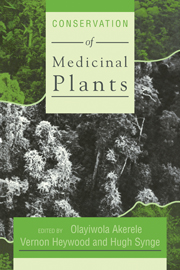Book contents
- Frontmatter
- Contents
- Contributors
- Preface
- Acknowledgements
- The Chiang Mai Declaration
- Introduction
- The Issue of Medicinal Plants
- 3 Global Importance of Medicinal Plants
- 4 Traditional Knowledge of Medicinal Plants – the Search for New Jungle Medicines
- 5 The Reason for Ethnobotanical Conservation
- Science, Industry and Medicinal Plants
- Techniques to Conserve Medicinal Plants
- Policies to Conserve Medicinal Plants
- Experiences from Programmes to Conserve Medicinal Plants
5 - The Reason for Ethnobotanical Conservation
Published online by Cambridge University Press: 07 September 2010
- Frontmatter
- Contents
- Contributors
- Preface
- Acknowledgements
- The Chiang Mai Declaration
- Introduction
- The Issue of Medicinal Plants
- 3 Global Importance of Medicinal Plants
- 4 Traditional Knowledge of Medicinal Plants – the Search for New Jungle Medicines
- 5 The Reason for Ethnobotanical Conservation
- Science, Industry and Medicinal Plants
- Techniques to Conserve Medicinal Plants
- Policies to Conserve Medicinal Plants
- Experiences from Programmes to Conserve Medicinal Plants
Summary
Nunc vospotentes omnes herbas deprecor,
exoro maiestatem vestrum, quasparens
tellus generavit et cunctis dono dedit.
A Roman prayer to all herbsIn the few parts of the world still not affected by fast encroaching civilization, there exists a wealth of information on the properties of plants that is still available to us. It will not long be there for us to salvage. It has been built up by peoples in primitive societies over millennia by trial and error, for they have had to rely on their ambient vegetation for foods, medicines and all the other necessities of life.
When our civilization arrives with roads, missionary activities, commercial interests, tourism or otherwise, the products of our culture are rapidly adopted and, often even in one generation, replace what has for hundreds of years been part of their culture. This erosion of native ethnobotanical knowledge and use is nowhere more rapid than in the realm of biodynamic plants – medicinal, narcotic and toxic species (Schultes & Hofmann, 1979,1980)
There have long been two strongly divergent poles in our evaluation of the worth of ethnobotanical studies. Many investigators have been carried away with enthusiasm that native peoples have had some special intuition that permitted them to seek out “nature's secrets”. Others have cast aside or denigrated all native folk lore as not worthy of serious scientific attention. Naturally, both points of view are extreme and are unwarranted.
Recently, the realization that the aboriginal knowledge of plant properties is of both academic and practical value has matured.
- Type
- Chapter
- Information
- Conservation of Medicinal Plants , pp. 65 - 76Publisher: Cambridge University PressPrint publication year: 1991
- 7
- Cited by

